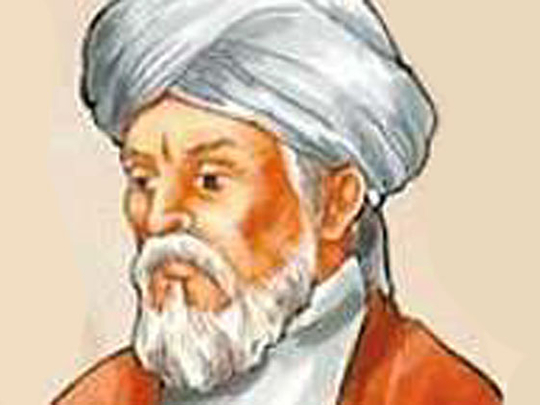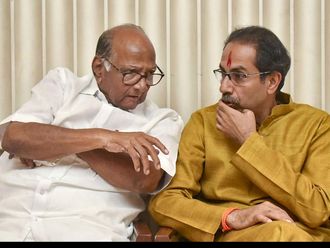
Abul Fath Abd Al Rahman Al Khazini (d.1121) was probably of Greek origin who became an astronomer and physician in Khorasan (Persia) at the beginning of the 12th century. Al Khazini, who converted to Islam and received a distinguished education, invented various scientific instruments— including the dioptra, which is a classical surveying instrument; the triquetrum, an instrument to find the altitude of heavenly bodies; variations of the quadrant and sophisticated astrolabes, etc — and though he was a pious man, he built his reputation as an impeccable scientist who relied on what could be measured.
His work on hydrostatic balance — when a fluid at rest is balanced between gravity and a pressure gradient force — was critical to explain why gravity, for example, prevented the Earth’s atmosphere from collapsing or from diffusing it into space. Khazini’s attention to detail sealed his reputation as an astronomers’ astronomer, perhaps best illustrated by his extensive work on weights, which he defined as the force inherent in solid bodies that causes them to move, of their own accord, in a straight line towards the centre of the earth and towards this centre only. He was, in short, a highly skilled astronomer who went from the theoretical world into the practical, invented useful tools to measure what could be calculated, and propelled successors to improve on his numerous inventions.
Times and Life
While little is known about his early life, he may well have been the son of a slave woman who was herded back from various conquests, and sold as cheap labour at one of numerous Khorasan markets. Several sources assume that he was born around 1077 in Marw, in the household of Ali Bin Mohammad Al Marwazi, a treasurer at the court in Marw.
The identity of his father was unknown though masters frequently took their slaves. In turn, Al Khazini became a young slave, though his master must have been impressed enough by his aptitude to allow him to study. Though the young charge lived a lonely life and never married, perhaps the sequels of his upbringing and his mother’s fate, he at least received an excellent education in astronomy, mathematics and physics.
Al Khazini was raised a Muslim and gradually excelled in his studies. Marw was then a centre of literary and scientific learning and drew many to its well-stacked libraries. The young man soon frequented the sharpest minds of the 12th century, and became a pupil of Umar Khayyam, among others. Though he enjoyed life to the fullest, Al Khazini, whose name reflects the city he grew up in, delved into mathematics and philosophy and remained a modest individual all through his life.
He apparently refused large financial advances for his works, satisfied with whatever he earned, which he deemed sufficient for his upkeep along with a lone cat. Various sources revealed that he seldomaccepted grants from his rulers and, according to Al Bayhaqi, he once declined 1,000 dinars fromthe Samanid Sultan Sanjar. The source reported that he only took 10 dinars for his services and requested that a mere 3 dinars ought to be allocated for his annual stipend since that was amply sufficient. When the ruler’s spouse sent him a gift of another 1,000 dinars, he returned it intact, pleading forgiveness.
In Marw, Al Khazini studied and worked with several senior astronomers such as Al Isfarazi (a prominent inventor of various instruments who probably inspired me more than any other teacher), Mohammad Abu Bishr Al Marwazi, and Abul Abbas Al Marwazi, as well as Hakim Al Hussain Al Samarqandi, all of whom were considered to be the most qualified astronomers at the time.
Al Khazini died around 1130, leaving behind a significant legacy, exemplified in several widely recognised books, including two major works, Mizan Al Hikmah (Balance of Wisdom) and Al Zij Al Sanjari, which were considered lost for centuries but that were miraculously discovered about 200 years ago.
Contributions to Astronomy
The Al Zij Al Sanjari, which was dedicated to Sanjar Bin Malikshah, then a leading Seljuk Sultan who ruled over Khorasan Province, revealed that Al Khazini occupied an official function though most learned men at the time were similarly beholden to philanthropists. What distinguished these tables from similar works was their attention to detail, which was the chief reason why the volume in which they appeared served as a textbook for Byzantine scholars such as Gregory Chioniades, an Orthodox bishop who lived in Tabriz in the late 1290s, and Theodore Meliteniotes, among others, who imparted the texts to fellow scientists.
In fact, this study earned a special place in astronomy because it contained chronologies and calendars as well as various tables for calculating “holidays and fasting, material related to the theory of Indian cycles, important developments in the theory of planetary visibility, and an elaborate set of eclipse tables”.
Although Al Khazini mastered theoretical works imparted by his teachers, he was equally interested in practical additions that would improve living conditions, and facilitate lives of the faithful.
In his work on astronomical instruments, for example, Al Khazini explained the uses of the triquetrum, or parallactic ruler, the diopter for measuring apparent diameters, the quadrant (also called a suds or sextant), his astrolabe, and various other devices to aid the naked eye, all of which were supposed to have practical application.
His Self Rotating Sphere demonstrated keen interest in connecting astronomy and applied mechanics, as he described a celestial globe that worked with weights. The instrument, in the shape of a solid sphere and marked with the stars and the standard celestial circles, was suspended halfway within a box. Al Khazini’s genius was to rotate the sphere once a day propelled by a weight falling from a leaking reservoir of sand, all to find arcs of importance in spherical astronomy.
Long before the German mathematician Christiernus Torchillus Morsianus (1458-1560) referred to air as matter with mass, and demonstrated that air had mass and behaved like liquids, it was Al Khazini who verified how the abstract weight of masses composed of two different materials behaved. He found that the weights of immersed masses were less than their real weights, and further explained that Archimedes’ principle applied to gases in addition to liquids.
What these discoveries led to were critical scientific discoveries over time, which further advanced our knowledge since other scientists could use these principles to invent the barometer, airvacuums and pumps, all of which followed rules elucidated in his work.
The Mizan Al Hikmah was an altogether different volume and was considered lost until a Consul General of the Russian Empire in Iran between 1845 and 1859, Nikolai Vladimirovich Khanykov, found the rare manuscript in Tabriz. In 1859, Khanykov published an essay on the book in the Journal of the American Oriental Society, describing the significance of its contents in mechanics and physics.
In summary, the study was a Middle Ages encyclopaedic work in the science of statics that incorporated earlier scholarly works from Ibn Al Haytham and many others. The treatise contained detailed assessments of the physical principles that underlied static and hydrostatic balance as well as the construction and use of instruments for these sciences.
Although the purpose of these discoveries was to enhance the sultan’s treasury by offering accurate differences between pure and adulterated metals as well as between real gems and fakes, Al Khazini’s work opened new vistas for applied mechanics that addressed views on mechanical problems first raised by Aristotle, Euclid and Archimedes.
While the Mizan Al Hikmah concentrated on mechanics and physics, Al Khazini was also interested to discover the way to determine the direction of the Qiblah from wherever a believer wished to pray. Naturally, while others delved in this area earlier, including Ibn Al Haytham and Al Biruni, Al Khazini surpassed them all because he relied on mechanical devices that were not subjected to the vagaries of the elements.
It was for this reason that he combined his tables with his spheres, which provided him an accurate reading of the direction a believer was asked to pray.
Legacy on Arabs and Muslims
To its credit, the orthodoxy of early Islam tolerated and encouraged the sciences, though a significant decline was recorded after Al Ghazali (d. 1111) introduced his famous objections, allegedly because such investigations led “to the loss of belief in the origin of the world and in the creator”.
Mercifully, this skewed perception did not prevent the rise of great independent thinkers, though what value was added increasingly occurred outside of Arabia, most notably in Central Asia and Iran. The 12th century, which marked a standstill in research activities, allowed for advanced practical discoveries and a lot less on theological/philosophical works that was both a good as well as a bad omen.
Muslim societies developed though at a slower pace, with Al Khazini’s voluminous book on “The Balance of Wisdom”, occupying a privileged spot. Seldom acknowledged in the mainstream—though widely known and lauded within the scientific community — Al Khazini’s investigations of the so-called “Roman” balance, or steelyard, along with his immensely critical remarks on specific gravity and the particular weight of alloys, stood as original contributions.
His assessment of the problem of the greater density of water when nearer to the centre of the Earth predated Roger Bacon’s work that proved the same hypothesis. Although few recall Al Khazini’s many contributions, he stands as one of the most effective scientists in the Muslim World even if, ironically, he was a mere Greek slave. His fortitude to excel against odds and use whatever opportunities existed were surely strengthened by faith as he harnessed his intellectual talents and served a nation caught in existential dilemmas.










